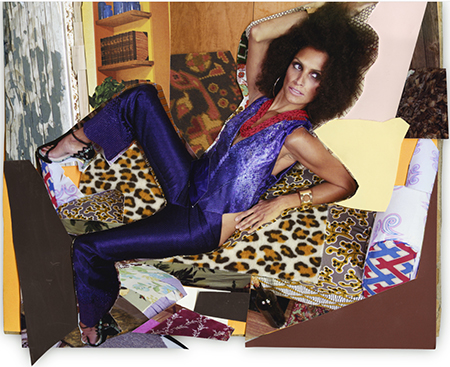
Continuing through May 13, 2018
Mickalene Thomas is an African American artist based in New York. She began exhibiting large-scale mixed media paintings in the mid 2000s. In those eye catching acrylic and enamel works, Thomas borrowed freely from fashion and art history, inserting black women into narratives from which they had been excluded. She often approached these works in a cubist manner, breaking an image apart and then collaging it back together to suggest the passage of time and a disorientation of space. What set her works apart was her desire to expand common definitions of beauty.
"Muse: Mickalene Thomas Photographs" is an exhibition and a book organized by the Aperture Foundation in New York. The collection was first presented in the Aperture galleries in 2016 and included a diverse selection of photographs Thomas created between 2001 and 2015, as well as the installation "Tête-à-Tête," with works by artists she admired and who were an influence on her work and thought process: Derrick Adams, Renée Cox, LaToya Ruby Frazier, Lyle Ashton Harris, Deana Lawson, Zanele Muholi, Malick Sidibé, Xaviera Simmons, Hank Willis Thomas and Carrie Mae Weems.
The exhibition traces the trajectory of her photographic works which paralleled her painting practice, specifically focusing on the idea of the muse and what it means to pose for the camera and for one another. Thomas' models were often women who were already a part of her life — friends, family, her mother — with whom she had an intimate and comfortable relationship and who were also readily willing to take on invented personas.
Thomas posed her female subjects in seductive and evocative poses in elaborately decorated tableaux. She designed them to simulate domestic settings from the 1960s and 1970s that might have appeared in Jet Magazine. Her goal was to present images of black women who were comfortable in their skin and in their relationships: women who were empowered and in control. In the artist’s words, "Any women — regardless of race, cultural identity or ethnicity — could look at these images, and something about (the model) — her elegance, her glamor, her vulnerability, her confidence, her stance, her composition — will remind them of themselves."
The exhibition includes large scale color photographs, black and white studies as well as collages that provide insight into Thomas' process and use of appropriated imagery. In "Racquel Leaned Back" (2013) Thomas collages an image of a woman in a bright purple jumpsuit into a den-like setting. The woman is evocatively posed on images of patterned pillows culled from myriad sources. Racquel's pose is echoed in the large scaled "La leçon d'amour," (2008), which depicts two fashionably dressed women, one in the lap of the other, blissfully draped on a fabric covered couch in the corner of a den that is best described as 1970s camp — filled with animal skin rugs, clashing patterned throws and vinyl records including "Jesus Christ Super Star."
In the self portrait, "Negress with Green Nails" (2005), Thomas, dressed in a bright green scooped-neck top that matches her long claw-like green fingernails, smiles directly into the camera as if to say, "this is me." In contrast, in "Quanikah Goes Up" (2001/2005), another self portrait, Thomas appears harried against the metallic sheen of an elevator. Her makeup is exaggerated, her hair dyed blond, her expression dazed, but with an air of desperation. Throughout the photographs in "Muse," Thomas explores varying female attitudes, desires and passions. Their presence asserts, "do not dismiss us, ignore us, direct prejudice toward us as we are beautiful, sensual, sexual and deserving of attention."
In both her paintings and photographic imagery Thomas is concerned with pose and posing. She uses photography to explore how "perception is put onto the black body." As she has stated, the work "was really about me searching, a discovery of myself, trying to understand some of these stereotypes that were a little mysterious to me ..."
